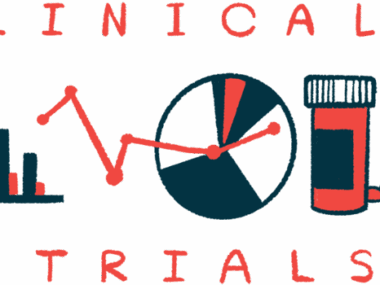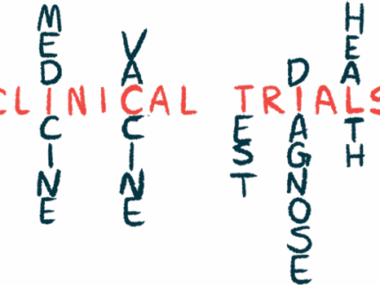Presentations highlight efzofitimod’s potential for pulmonary sarcoidosis
Therapy could fill need for safer treatment options, its developer says
Written by |

Many people with moderate or severe pulmonary sarcoidosis — the target market for the investigational therapy efzofitimod — are highly burdened by the disease and are dependent on corticosteroids that can have serious side effects, according to real-world analyses.
“New real-world evidence underscores the growing burden of patients living with pulmonary sarcoidosis and the continued reliance on oral corticosteroids as the standard of care, despite their limited clinical evidence and toxic side effects,” Sanjay S. Shukla, MD, president and CEO of efzofitimod’s developer, Atyr Pharma, said in a company press release.
The company believes its experimental treatment could fill a need for more efficacious and safer treatment options in this patient population.
Findings shared at American Thoracic Society conference
Participants in the Phase 3 EFZO-FIT clinical trial (NCT05415137), which is testing efzofitimod against a placebo in 264 pulmonary sarcoidosis patients, are generally representative of this target population. Atyr has already aligned with U.S. regulators on the study’s main outcome measure, and results are due later this year.
“We believe efzofitimod shows great promise to be a transformative therapy in this underserved market and we look forward to sharing topline results in the third quarter of this year [July to September],” Shukla said.
All these findings are being discussed in three poster presentations at the American Thoracic Society 2025 International Conference, being held May 16-21 in San Francisco.
In sarcoidosis, abnormal clumps of immune cells called granulomas accumulate in various tissues and can cause inflammation and scarring (fibrosis). Pulmonary sarcoidosis, where the disease affects the lungs, leads to symptoms like shortness of breath, coughing, and chest pain.
Oral corticosteroids have strong immunosuppressive effects and are the current first-line treatment option, but they can cause serious side effects when used long term or at high doses.
Other treatments may be used to minimize the need for corticosteroids, but have their own drawbacks, including an increased risk of infections due to broad immunosuppression.
In two of the poster presentations, scientists looked at real-world data to further assess the frequency, burden, and treatment patterns of pulmonary sarcoidosis in the U.S.
Results detailed in the poster “Incidence, Prevalence, and Mortality of Pulmonary Sarcoidosis with Parenchymal Involvement in the US” showed that nearly 160,000 people in the U.S. have pulmonary sarcoidosis with involvement of gas exchange-related lung tissue, with an estimated 30,000 new cases every year. The disease disproportionately affects women and Black people, and 40% of patients are older than 65 years.
About one in every eight people with pulmonary sarcoidosis are hospitalized within three years, and patients ages 65 to 74 have a mortality rate nearly twice as high as that of the general population.
Corticosteroids more commonly used than previously thought
Real-world treatment patterns, based on insurance claims data, were presented in a poster, titled “Real-World Treatment Patterns Among Pulmonary Sarcoidosis Patients with Parenchymal Involvement in the US.”
Corticosteroids are the most commonly used pulmonary sarcoidosis treatment, results showed, but usage rates are even higher than previously estimated. “Only 8% of patients do not use glucocorticoids as their initial treatment type,” the researchers wrote.
In addition, 75% of patients given other medications as their second-line treatment continue to use corticosteroids, “highlighting challenges with tapering despite safety concerns and treatment guidelines,” the release stated.
Patients needing first-line treatment seemed to progress quickly to needing additional therapies thereafter, with second-line therapies begun within seven months of first-line treatment, and third-line therapies begun within one year of second-line treatment.
“These findings highlight a clear and urgent need for safer, more effective treatments for patients with this chronic disease,” Shukla said.
Infused directly into the bloodstream, efzofitimod works to modulate the activity of immune cells implicated in sarcoidosis by binding to a protein found on their surface called neuropilin-2. This is expected to help resolve inflammation and prevent fibrosis development without influencing healthy immune responses needed to fight infections.
These findings highlight a clear and urgent need for safer, more effective treatments for patients with this chronic disease.
EFZO-FIT, which completed enrollment of 268 people last year, is assessing the safety and efficacy of efzofitimod (3 mg/kg or 5 mg/kg), infused once every four weeks, against a placebo in adults with pulmonary sarcoidosis who are on corticosteroids.
The main efficacy goal is to assess patients’ ability to taper off corticosteroids after nearly a year of treatment, with lung function and life quality as secondary outcome measures.
In the poster “EFZO-FIT, the Largest Placebo-Controlled Trial in Pulmonary Sarcoidosis,” researchers showed the 264 dosed participants were reflective of a population with moderate to severe chronic symptomatic pulmonary sarcoidosis.
Participants’ mean age is 53.8, 56.8% are men, and 64% are white. More than a third (38.3%) were on corticosteroid-sparing immunosuppressants on top of oral corticosteroids, whose mean dose at the study’s start was 10.55 mg.
“We are pleased to report that we have enrolled a [group] of pulmonary sarcoidosis patients in our ongoing Phase 3 EFZO-FIT study that we believe is … reflective of a moderate to severe patient population that we see as the target market for efzofitimod,” Shukla said.
An independent data and safety monitoring board has reviewed safety findings from the trial four times to date as well. With each review, it found no significant safety risks and recommended the study proceed as planned without modifications.







